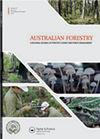Silviculture and fire effects on understorey flowering in jarrah forest
IF 1.2
4区 农林科学
Q3 FORESTRY
引用次数: 3
Abstract
ABSTRACT Long-term forest monitoring undertaken by Forestcheck since 2001 has examined the effects of silvicultural treatment on floral diversity and assemblage composition in the jarrah forest of southwest Western Australia. Both prescribed burns and wildfires have overlain the network of Forestcheck monitoring sites, providing the opportunity to examine fire and silviculture interactions in natural experiments and allowing experimental control of time-since-fire effects on the flora. We report here two opportunistic experiments. First, the early effects of prescribed burns in spring on the flowering of the vascular flora were compared with closely paired sites that were long unburnt. Second, the early effects of a wildfire in summer on the flowering of the vascular flora were compared between silvicultural treatments. Flowering richness tended to be less on burnt grids in the non-peak period in the first two years after fire in one experiment, but there were no differential effects of silviculture on flowering assemblages arising from interaction with wildfires. Flowering assemblages varied from year to year and the extent to which they varied differed between locations but not as a result of silvicultural treatments. We conclude that no special management with respect to plant flowering is required to remedy outcomes of interaction between wildfire and silvicultural treatments. Further information is needed to understand the long-term implications of variability in flowering assemblages and how it affects the reproductive viability of understorey species and their interactions with pollinator networks in the face of a changing climate.造林和火对jarrah林下开花的影响
Forescheck自2001年以来进行的长期森林监测研究了造林处理对西澳大利亚西南部jarrah森林植物多样性和群落组成的影响。规定的烧伤和野火都覆盖了Forescheck监测点的网络,为在自然实验中研究火灾和造林的相互作用提供了机会,并允许对火灾对植物群影响后的时间进行实验控制。我们在这里报告两个机会性实验。首先,将春季规定烧伤对维管植物群开花的早期影响与长期未烧伤的紧密配对部位进行了比较。其次,比较了不同造林处理对夏季野火对维管植物群开花的早期影响。在一项实验中,在火灾发生后的前两年,在非高峰期,烧毁的网格上的开花丰富度往往较低,但造林对与野火相互作用产生的开花组合没有不同的影响。开花组合逐年变化,不同地点的开花组合变化程度不同,但不是造林处理的结果。我们得出的结论是,不需要对植物开花进行特殊管理,就可以补救野火和造林处理之间相互作用的结果。需要进一步的信息来了解开花组合变异的长期影响,以及在气候变化的情况下,它如何影响下层物种的繁殖能力及其与传粉昆虫网络的相互作用。
本文章由计算机程序翻译,如有差异,请以英文原文为准。
求助全文
约1分钟内获得全文
求助全文
来源期刊

Australian Forestry
FORESTRY-
CiteScore
3.70
自引率
4.80%
发文量
15
审稿时长
>12 weeks
期刊介绍:
Australian Forestry is published by Taylor & Francis for the Institute of Foresters of Australia (IFA) for scientific, technical, and professional communication relating to forestry in the Asia Pacific.
 求助内容:
求助内容: 应助结果提醒方式:
应助结果提醒方式:


